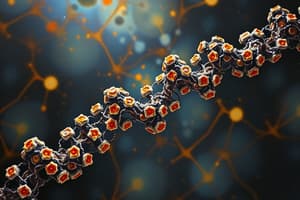Podcast
Questions and Answers
What is the approximate increase in transcription initiation stimulated by activation domains?
What is the approximate increase in transcription initiation stimulated by activation domains?
- Hundredfold (correct)
- Thousandfold
- Ten thousandfold
- Tenfold
What is the typical characteristic of the promoter region of a gene?
What is the typical characteristic of the promoter region of a gene?
- Absence of a TATA box altogether
- Absence of a readily classifiable mother TATA box (correct)
- Presence of a readily classifiable father TATA box
- Presence of a readily classifiable mother TATA box
What is the role of activation domains in gene expression?
What is the role of activation domains in gene expression?
- Terminating transcription prematurely
- Stimulating transcription initiation (correct)
- Regulating transcription elongation
- Inhibiting transcription initiation
What is the relationship between the TATA box and the gene promoter region?
What is the relationship between the TATA box and the gene promoter region?
What is the effect of the absence of a readily classifiable mother TATA box on gene expression?
What is the effect of the absence of a readily classifiable mother TATA box on gene expression?
What is the common feature of the amino terminal helices in the binding of DNA?
What is the common feature of the amino terminal helices in the binding of DNA?
Which of the following motifs is NOT involved in the dimerization of the DNA-binding protein?
Which of the following motifs is NOT involved in the dimerization of the DNA-binding protein?
What is the primary function of the zinc finger motif in DNA-binding proteins?
What is the primary function of the zinc finger motif in DNA-binding proteins?
What is the characteristic of the leucine zipper motif in DNA-binding proteins?
What is the characteristic of the leucine zipper motif in DNA-binding proteins?
What is the primary function of the helix-turn-helix motif in DNA-binding proteins?
What is the primary function of the helix-turn-helix motif in DNA-binding proteins?
Where does a polypeptide hormone bind to its receptor?
Where does a polypeptide hormone bind to its receptor?
What is the direct result of a steroid hormone binding to its receptor?
What is the direct result of a steroid hormone binding to its receptor?
What is the primary function of a hormone-producing cell?
What is the primary function of a hormone-producing cell?
What occurs when a polypeptide hormone binds to its receptor in a target cell?
What occurs when a polypeptide hormone binds to its receptor in a target cell?
What is the key difference between polypeptide and steroid hormones in terms of their mechanism of action?
What is the key difference between polypeptide and steroid hormones in terms of their mechanism of action?
What is the function of the protein encoded by the RAP1 gene?
What is the function of the protein encoded by the RAP1 gene?
What is the name of the gene that codes for the protein Rap1p?
What is the name of the gene that codes for the protein Rap1p?
What is the primary function of Rap1p in relation to telomeres?
What is the primary function of Rap1p in relation to telomeres?
What is the region of the DNA that Rap1p binds to?
What is the region of the DNA that Rap1p binds to?
What is the role of Rap1p in telomere maintenance?
What is the role of Rap1p in telomere maintenance?
What is the primary mechanism of regulation of galactose utilization in yeast?
What is the primary mechanism of regulation of galactose utilization in yeast?
What is the significance of the GAL1 and GAL10 genes in yeast?
What is the significance of the GAL1 and GAL10 genes in yeast?
Why is the GAL system an ideal model for studying gene regulation?
Why is the GAL system an ideal model for studying gene regulation?
What is the role of the UAS in the regulation of galactose utilization in yeast?
What is the role of the UAS in the regulation of galactose utilization in yeast?
What is the significance of the GAL locus in yeast?
What is the significance of the GAL locus in yeast?
Flashcards are hidden until you start studying
Study Notes
Gene Regulation
- Transcription initiation can be stimulated up to a hundredfold by activation domains.
- Specific DNA-binding motifs include helix-turn-helix (HTH), zinc finger, and leucine zipper.
Hormone Signaling
- Hormone-producing cells release polypeptide hormones that bind to receptors embedded in the plasma membrane.
- The binding of a hormone to its receptor triggers a signal transduction pathway, leading to a cellular response.
- Steroid hormones bind to their receptors in the target cell plasma membrane, activating them.
Telomere Regulation
- Rap1p (product of the RAP1 gene) binds to telomere repeat sequences.
- This binding is important for regulating telomere function.
Regulation of Galactose Utilization in Yeast
- Gal4p dimer binds to upstream activation sequences (UAS) to regulate GAL1 and GAL10 gene expression.
- The GAL genes are not regulated by a UAS, but are instead controlled by other mechanisms.
- The regulation of galactose utilization in yeast is a well-studied system that illustrates several important principles of gene regulation.
Studying That Suits You
Use AI to generate personalized quizzes and flashcards to suit your learning preferences.




